|
The banknotes were designed by Robert Kalina, designer at the Austrian national central bank in Vienna, who won the design competition. His designs were inspired by the theme "Ages and styles of Europe". He has depicted the architectural styles of seven periods in our rich cultural history (classical, roman, gothic, renaissance, baroque and rococo, steel and glass architecture, modern 20th century architecture). The resulting banknotes are attractive, have a number of security features and are representative of all the Member States involved.
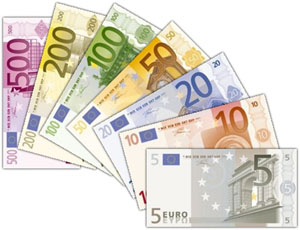
On the front of the banknotes, windows and gateways symbolise the spirit of openness and co-operation in Europe. The 12 stars of the European Union appear on each banknote. On the reverse, a bridge from the same architectural period is featured, symbolising the close co-operation and communication within Europe, and between Europe and the world. The seven denominations of banknotes are printed with different dominant colours to aid identification. The size of the banknotes varies, increasing with the value. The €5 banknote is the smallest and the €500 the largest. The other main features of every euro banknote are:
- The name of the currency written in both the Latin (EURO) and the Greek (EYPO) alphabets
- The initials of the European Central Bank in the five linguistic variants - BCE, ECB, EZB, EKT, EKP - covering the 11 official languages of the European Community
- The symbol © indicating copyright protection
- The signature of Willem F. Duisenberg, President of the European Central Bank
- The flag of the European Union
The different sizes and the bold, contrasting colours with "touch and feel" characteristics will help the blind and the partially sighted to identify the banknotes. These are just two of the four features incorporated into the banknotes after consultation with the European Blind Union. The other two features are: the printing of the values in large, bold figures, and the use of the intaglio printing process for some elements of the banknotes. Intaglio printing leaves the print raised in relief. Such tactile marks are also printed along the edges of the higher-value €200 and €500 banknotes.
Commemorative issues
Euro commemorative coins are commemorative variations of euro circulation coins, in the sense that they have a different national side from the standard one, and commemorate a specific event or personality. They comply with the denominations and with the technical specifications of euro circulation coins and have legal tender status throughout the euro area. As these coins must bear one of the common sides, the commemorative feature must appear on the national side so that the common side remains unaffected.
The volume of coins and/or the production period of this coin variation are limited. It has been agreed between Member States and the Commission that all commemorative coin issues would be limited to a single coin denomination (€2). Euro collector coins, on the other hand, are not intended for circulation and must differ from regular euro coins, therefore:
- Their face value is different;
- They do not use images which are similar to the common and national sides of the circulation coins;
- Colour, diameter and weight differ significantly from the coins intended for circulation in at least two of these three characteristics
- The legal tender status of these coins is also limited to the country of issue
Euro collector coin issues
According to the Conclusions of the Ecofin Council meeting on January 31, 2000, to ensure that Euro collector coins will be readily distinguishable from Euro coins intended for circulation, the coins must bide to the following rules:
- The face value of collector coins should be different from that of the coins intended for circulation (i.e. Euro coins cannot have a face value equal to the 8 denominations: 1, 2, 5, 10, 20, 50 Euro cent and 1 and 2 Euro)
- Collector coins should not use images, which are similar to the common sides of the euro coins intended for circulation. Furthermore, as far as possible, the designs used should also be at least slightly different from those of the national sides of circulation coins
- Out of colour, diameter and thickness, euro collector coins should differ significantly from the coins intended for circulation in two respects
- Collector coins should not have a shaped edge with fine scallops, or "Spanish flower"
- The identity of the issuing Member State should be clearly and easily recognisable
Euro collector coins may be sold at or above face value and the approval for the volume of collector coins issue should be sought on an aggregate basis rather than for each individual issue. With respect to collector coins' denominations, that may coincide with the low denominations of euro banknotes, there does not seem to exist any significant risk of substitution. However, Member States should stand ready to consider any demands by the ECB on this matter. While Euro collector coins will have legal tender status in the issuing Member State, the competent authorities (NCBs, Mints or other institutions) should set up temporary arrangements through which owners of euro collector coins issued in other euro area Member States can receive the face value of those coins while bearing the costs related to this transaction.
Description of euro banknotes
| Denomination |
Dimensions |
Dominant Colour |
Architecture |
Period |
Printercode position |
| 5 euro | €5 |
120 x 62 mm |
Grey |
Classical |
< 5th century |
|
| 10 euro | €10 |
127 x 67 mm |
Red |
Romanesque |
11-12th centuries |
|
| 20 euro | €20 |
133 x 72 mm |
Blue |
Gothic |
13-14th centuries |
|
| 50 euro | €50 |
140 x 77 mm |
Orange |
Renaissance |
15-16th centuries |
|
| 100 euro | €100 |
147 x 82 mm |
Green |
Baroque & Rococo |
17-18th centuries |
|
| 200 euro | €200 |
153 x 82 mm |
Yellow-brown |
Iron & Glass |
19-20th centuries |
|
| 500 euro | €500 |
160 x 82 mm |
Purple |
Modern |
20-21st centuries |
|
| Front (recto, obverse) |
Value |
Back (verso, reverse) |
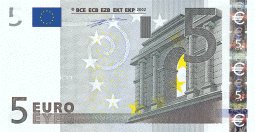 |
€ 5 |
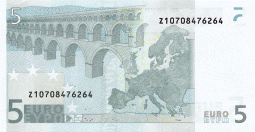 |
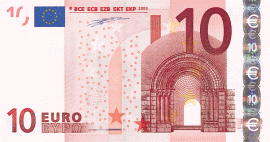 |
€ 10 |
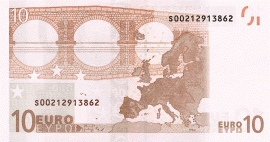 |
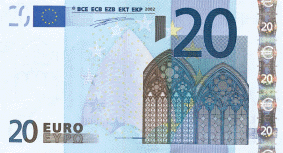 |
€ 20 |
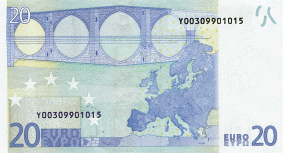 |
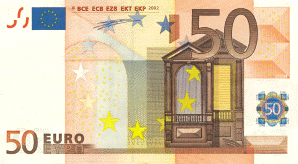 |
€ 50 |
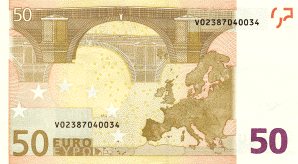 |
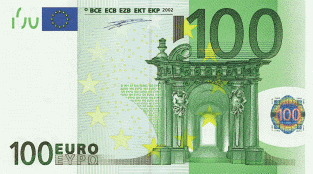 |
€ 100 |
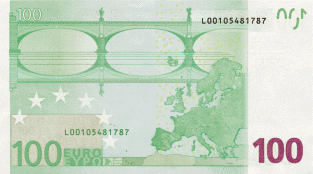 |
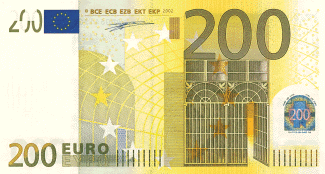 |
€ 200 |
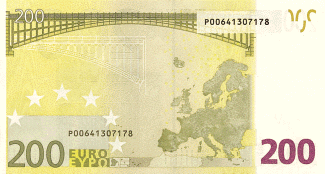 |
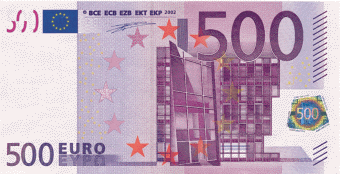 |
€ 500 |
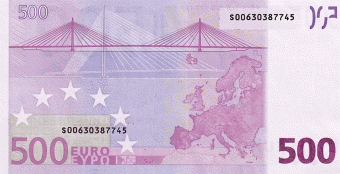
|
Country letters
Unlike the euro coins, the euro notes do not have a national side indicating where they're from. This information is instead encoded within the note's serial number.
The first letter of the serial number uniquely identifies the country that issues the note. The remaining numbers (when added up and the digits of the resulting sum then added together again until a single digit remains) give a checksum also particular to that country. The W, K and J codes have been reserved for the EU member states currently not participating in the euro.
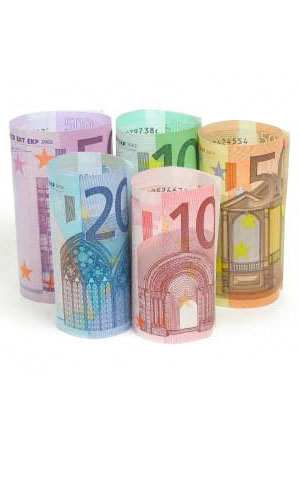
National identification codes
| Code |
Country |
Checksum |
Z |
Belgium |
9 |
Y |
Greece |
1 |
X |
Germany |
2 |
(W) |
(Denmark) |
(3) |
V |
Spain |
4 |
U |
France |
5 |
T |
Ireland |
6 |
S |
Italy |
7 |
R |
Luxembourg |
8 |
(Q) |
Not Used |
(9) |
P |
Netherlands |
1 |
(O) |
Not Used |
(2) |
N |
Austria |
3 |
M |
Portugal |
4 |
L |
Finland |
5 |
(K) |
(Sweden) |
(6) |
(J) |
(United Kingdom) |
(7) |
|

